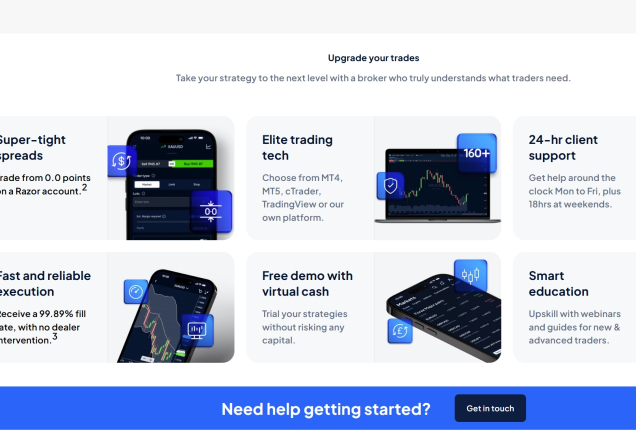Pepperstone List of Supported & Banned Countries
Pepperstone is a highly respected online forex and CFD broker, established in 2010. They offer competitive trading conditions and a user-friendly platform, attracting traders worldwide. Since its establishment, the broker has grown to serve clients in many countries, totalling over 170. However, despite its global reach, Pepperstone does not accept clients from certain countries. In this article, we’ll explore Pepperstone’s list of supported and banned countries. We will also look at a few alternatives that traders can use.
Not sure if Pepperstone accepts traders from your country? Try opening an account, if this works, they welcome traders from your country
75.3% of retail CFD accounts lose money
Pepperstone List of Supported Countries
Pepperstone is trusted by a global community of over 400,000 traders and operates internationally through multiple entities regulated by Tier-1, Tier-2, and Tier-3 authorities. These include:
ASIC
Australia - Pepperstone Group Limited is licensed by the ASIC (Australian Securities & Investments Commission) in Australia. This license allows Pepperstone to accept traders from Australia.
FCA
UK - Pepperstone Limited is authorised and regulated by the FCA (Financial Conduct Authority) in the UK. This license only allows Pepperstone to accept traders from the UK.
CySEC
Cyprus - Pepperstone EU Limited is overseen and regulated by the CySEC (Cyprus Securities and Exchange Commission) in Cyprus. The CySEC license allows brokers to operate freely within EU state countries, thanks to the European Economic Area (EEA) agreement and MiFID standards. These are the countries where the broker can legally operate under the CySEC license, allowing Pepperstone to accept traders from:
- Austria
- Belgium
- Bulgaria
- Croatia
- Cyprus
- Czechia
- Denmark
- Estonia
- Finland
- France
- Germany
- Greece
- Hungary
- Ireland
- Italy
- Latvia
- Lithuania
- Luxembourg
- Malta
- Netherlands
- Poland
- Portugal
- Romania
- Slovakia
- Slovenia
- Spain
- Sweden
BaFin
Germany - Pepperstone GmbH holds a license from the BaFin (Federal Financial Supervisory Authority) in Germany. Since Germany is an EU member state, BaFin-licensed brokers can operate in other EU member states without needing an additional license. As such, this license also applies in the countries named above in the CySEC’s section.
DFSA
Dubai - Pepperstone Financial Services (DIFC) Limited is regulated by the DFSA (Dubai Financial Services Authority) in Dubai. While DFSA-regulated brokers are primarily based in the DIFC, they can operate within the UAE. So Pepperstone also accepts traders from Dubai and UAE.
CMA
Kenya - Pepperstone Markets Kenya Limited holds a regulatory license from the CMA (Capital Markets Authority) in Kenya. CMA-regulated brokers are not typically authorised to offer cross-border services to clients in other jurisdictions.
SCB
Bahamas - Pepperstone Markets Limited is regulated by the SCB in the Bahamas. While SCB-regulated brokers are primarily licensed to operate domestically, they may extend their services internationally, provided they adhere to the regulatory requirements of each jurisdiction they intend to serve.
Pepperstone Prohibited Countries
While Pepperstone has licenses and authorisation in many jurisdictions, it does not accept clients from all countries. Notably, Pepperstone does not accept clients who are permanent residents or nationals of United States, Afghanistan, American Samoa, Canada, Congo-Kinshasa, Congo-Brazzaville, Central African Republic, Cote d’Ivoire, Crimea, Democratic People’s Republic of the Congo, Democratic People's Republic of Korea (North Korea), Eritrea, Guinea-Bissau, Iran, Iraq, Japan, Kazakhstan, Lebanon, Liberia, Libya, Mali, Myanmar, New Zealand (retail clients only), South Korea, Somalia, South Sudan, Sudan, Syria, U.S. Outlying Islands, U.S Virgin Islands, Yemen, or Zimbabwe.
Please note that Pepperstone might update this list of countries from time to time. As such, it is important for traders to always check with Pepperstone directly to confirm their availability in various regions.
| Important: If your country isn’t listed under either supported or banned regions, it generally means that Pepperstone accepts traders from your location. To be absolutely sure, go to their official website, click “Join Now,” and check if your country appears in the dropdown menu—if it’s there, you’re eligible to sign up. |
What Pepperstone Offers
Pepperstone has several features that traders look for on a broker site. For starters, Pepperstone provides access to over 1,200 different CFDs. These include CFDs on forex, indices, commodities, cryptocurrencies, currency indices, ETFs, and share markets. To trade these various market products, Pepperstone avails MetaTrader 4, MetaTrader 5, cTrader, TradingView, and Pepperstone Trading Platform.
Further, this broker has some industry-standard spreads and fees. Pepperstone offers two primary account types for trading: the Standard Account and the Razor Account. The Standard Account features spreads starting from as low as 1.0 pips on major currency pairs, with no additional commission fees. Meanwhile, the Razor Account provides raw spreads beginning at 0.0 pips but applies a commission based on the trading platform used.

For MetaTrader 4 and MetaTrader 5, the commission is $3.5 or €2.6 per side per lot, depending on the account's base currency. TradingView charges a similar commission of $3.5 per side per lot. cTrader, however, offers a slightly lower commission of $3 per side per lot. For accounts in currencies other than USD, TradingView and cTrader commissions are converted at the spot exchange rate to the account currency.
Unfortunately, these remarkable features are not accessible to traders globally. There are various countries from which Pepperstone does not accept traders.
75.3% of retail CFD accounts lose money
Top Alternatives to Pepperstone
If Pepperstone is not available in your region, there are other reputable brokers that offer comparatively similar trading conditions. Here are a few alternatives:
Forex.com (Alternative For US, EU and International Traders)
Forex.com is a globally recognised broker with a strong regulatory framework. It is an excellent alternative for traders in the US, the EU, and international traders in general. This broker offers its traders ample opportunities to diversify their portfolios. For traders in the US, forex, futures, and futures options are the asset classes available to trade. In contrast, traders outside the US can trade CFDs on forex, stocks, indices, cryptocurrencies, commodities, and precious metals. To trade these various market products, investors can use a variety of trading platforms including MetaTrader 4, MetaTrader 5, TradingView, and Forex.com Trader.

In terms of spreads, this broker’s offering is within market standards. The Standard Account offers spreads starting as low as 0.8 pips, while the MetaTrader Account begins at 1.0 pips, both with zero commission. Alternatively, the Raw Account provides spreads as low as 0.0 pips, accompanied by a commission of $5 per $100,000 traded. For traders in the US, the commission on the raw account is $7 commission per $100,000 traded.
On regulations, Forex.com holds regulatory licenses from several well-regarded institutions. Its parent company, StoneX, holds regulatory licenses from the FCA, the ASIC, the CySEC, the CIRO in Canada, and the CFTC and NFA in the US.
76-77% of retail investor accounts lose money when trading CFDs with this provider.
OANDA (Alternative for US Traders)
OANDA is a well-established forex broker founded in 1996, with a strong reputation for transparency and regulation. They are a good alternative for US traders who cannot use Pepperstone. OANDA is registered with the CFTC and is a member of the NFA in the US. This ensures that OANDA operates in strict accordance with US financial regulations.
Notably, there are only two market classes available to trade on OANDA US. Over 70 different currency pairs and a variety of cryptocurrencies are available for trading on OANDA. Oanda US primarily charges traders through spreads. Fortunately, the spreads on this platform are competitively low, which is a positive aspect. For major currency pairs, spreads start as low as 1.4 pips. The trading platforms available to use in trading include Oanda Web, Oanda Mobile, TradingView, and MetaTrader 4.
Risk warning: Trading margined products carries a high level of risk.
XM (Alternative for International Traders)
XM is a globally renowned broker that caters to traders in over 190 countries, making it an excellent alternative to Pepperstone for international traders. Established in 2009, XM is famous for its broad accessibility, multilingual support, and user-friendliness. Positively, XM operates under the regulation of multiple esteemed authorities including the CySEC, the ASIC and the FSC in Belize.
On another note, XM provides access to over 1,000 trading instruments. These include CFDs on forex, stocks, indices, precious metals, and energies. As such, traders can spread their investment across various assets. The trading platforms available to traders include MetaTrader 4, MetaTrader 5, and XM’s trading app.
There are three main accounts to choose from including the the Standard Account, the Ultra Low Account, and the Shares Account. The standard account offers spreads as low as 1.6 pips for major currency pairs with no commission charged. In contrast, the XM Ultra Low account offers lower spreads from 0.8 pips on major currency pairs, also without a commission. Finally, the shares account charges a commission depending on the asset traded and the size of the position.
75.18% of retail investor accounts lose money when trading CFDs with this provider.
Conclusion
Pepperstone is undoubtedly one of the top brokers in the forex and CFDs space. It offers traders great trading conditions, backed by a strong regulatory background. Despite being a great broker, Pepperstone's restrictions leave some traders out.
For traders in these excluded areas, reputable alternatives like Forex.com, OANDA, and XM are some great alternatives. They provide comparable features, strong regulatory oversight, and diverse trading opportunities. Needless to say, there are many other reputable brokers that may well fit a trader that we did not name here. Ultimately, traders should choose a broker that aligns with their needs, ensures regulatory compliance, and supports their trading goals.

Top-Tier Trusted Brokers
The table below contains links to 3rd party websites of our top partners from whom we receive compensation at no additional cost to you.


























